Home care
After purchase, the plant is washed under a tap of water. Then they are transplanted into other, more free containers. The flower can grow as a cover plant or ampelous. The cover is installed on coffee tables, window sills.
Ampelnoe - can grow in pots, cabinets, bookshelves. Growing in hydroponics is allowed. Very often this plant can be found in florariums, gardens, flower greenhouses. The plant looks great alone or surrounded by other flowers.
Pruning
Sometimes the top can be trimmed. Thanks to this procedure, the dweller will not go up, but to the sides. A sprawling wide bush is formed (we talked about bushy indoor plants in this material).
The cut stems can be used for propagation. Therefore, pruning is carried out in the spring after the plant wakes up from a dormant period.
Watering
Watering should be systematic and regular. Do not allow the earthen coma to dry out. With a lack of moisture, the flower may die.
The most optimal watering option is a slight drying out of the upper part of the earth.
Sometimes the flower is sprayed with water from a spray bottle.
Landing
Since the root system of the plant is small, it is necessary to use shallow and wide containers. Then Pellionia can be a ground cover plant. In this case, a magnificent "carpet" appears. If the root system is the largest and cannot be used for covering, the pet is planted in deep containers. You can use pots, vases, or wooden pallets.
Ampel cultivation allows the plant to grow in pots. In this case, the flower is placed just below the eyes of the beholder. Then you will see not the seamy side of the leaves, but the front. Fill half of the container with a drainage system. Pebbles or expanded clay will do.
Small holes are made at the bottom of the container. Fall asleep with soil. The pet is placed in the center. Sprinkle with soil. Water abundantly.
Transfer
This representative of the flora grows well in nutritious, fortified soil. You can use purchased soil for home flowers or prepare the substrate yourself. This will require compost soil mixed with greenhouse soil. Humus and fine-grained sea sand are added.
It is imperative to add peat to the ground, since Pellionia loves an acidic environment.
If peat is in small quantities or not added at all, the ornamental shrub will grow very poorly. There is a possibility of death. The plant is transplanted as the root system fills the container. Large containers are used for transplants.
Top dressing
The plant needs systematic infrequent feeding. You can feed the flower once a month. In winter, feeding is stopped. Store-bought preparations for decorative flowers are well suited.
The concentration is diluted 2-3 times lower than indicated on the label. Otherwise, the plant can be burned. Due to the acidic environment in which the ornamental shrub grows, an unwanted chemical reaction can occur.
Do not allow direct contact with plant roots.
Temperature
The flower does not like excessive heat. The optimum temperature in winter can vary between 17-19 ° C. The pet does not like strong drops.
This representative of the flora should not be kept near hot radiators. In dry hot air, the plant quickly loses its decorative effect. The leaves begin to turn yellow and fall off.
Lighting
The decorative bush grows well in the depths of the illuminated room. Can be placed on cabinets, tables, bookshelves. But when placing you need to be aware of the love of shade.
It is forbidden to put the flower on the windowsills with the windows open. It reacts negatively to direct sunlight.
The sun burns the plant, after which brown spots appear and the plant stops growing. In winter, due to lack of light, the flower can be moved closer to the window. Additional artificial lighting is not required.
On our site there are many materials about other plants, for example, about avocado, banana, trees, lianas, false palms, ferns, carnivorous plants, decorative deciduous, about the medicinal mint Plectrantus.
Possible plant diseases
Pellionia is very resistant to various diseases. But sometimes it can be affected by aphids and whiteflies, which start up in dry air and high indoor temperatures. For prevention purposes, you should arrange a shower for the plant, pouring warm water. If you find pollen on a flower that looks like flour, then these are traces of the presence of a whitefly, and Pellionia must be treated with the preparations "Aktara" or "Fitoverm". If aphids are present, remove the affected areas and treat the plant with a mild soapy solution.
Unfortunately, Pellionia is not a popular houseplant these days, although it looks beautiful in compositions with other flowers, it is no less beautiful as an ampel plant in hanging pots and is effective as a ground cover plant in combination with flowering specimens. In addition, Pellionia perfectly cleans the air, destroys harmful microbes and microorganisms.
See below about caring for Pellionia.
1.Pellionia - home care
1.1 Temperature of keeping the flower
Pellionia is a thermophilic plant and can be kept at normal room temperature throughout the year. In the winter months, the temperature of the content should not fall below 13 ° C.
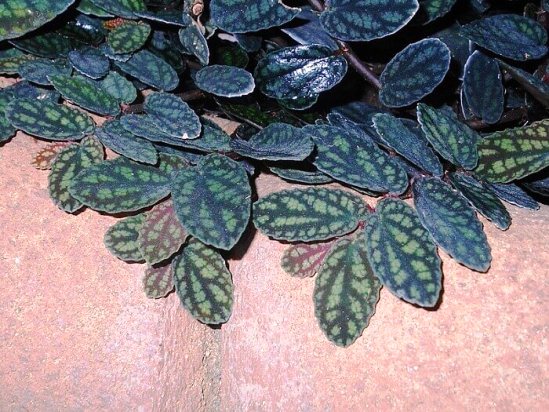
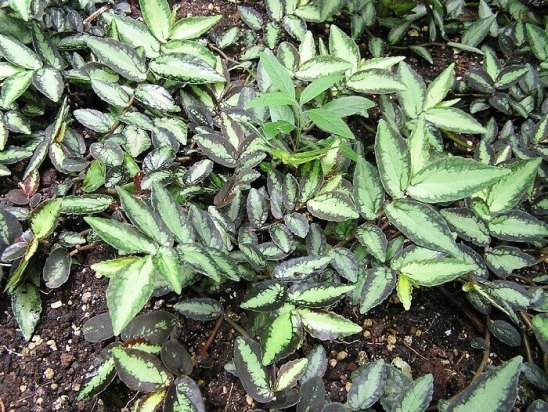
1.4 How to care
Pellionia is fairly easy to grow. Long stems can be trimmed to achieve a compact shape. Remove weak and diseased shoots. The tips of young shoots are pinched to form a dense plant.
1.5 Reproduction of Pellionia
Stem apical cuttings 7-10 cm long, taken when pruning in spring or early summer. The lower leaves are removed from the cuttings and powdered with growth hormones, young plants are placed in a warm place with a temperature of about 25 ° C. Rooting is carried out in moist peat with the addition of sand, under a glass shelter for 3 to 5 weeks. Seeds are sown in spring. The division of large plants is carried out in the spring, when transplanting.
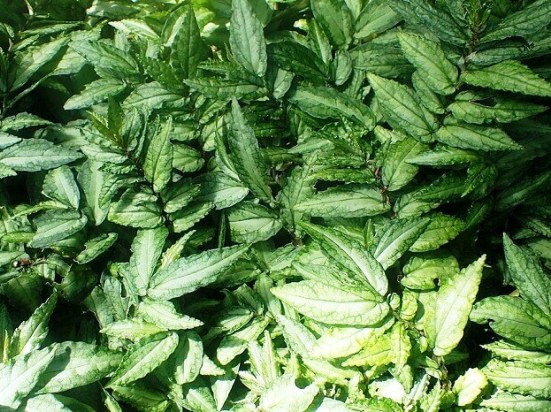
1.6 Soil
Nutrient soil, consisting of sphagnum moss, leaf humus, peat. To improve drainage, coarse river sand is added.

1.8 Purpose
Valuable decorative leafy plant. Pellionia can be grown in hanging baskets and pots, or as a groundcover.
1.9 Air humidity
High - Place a room humidifier near the plant or surround the pot with a layer of damp sphagnum. You can spray with soft water at room temperature. Pellionia hates drafts - keep the plant away from doorways.
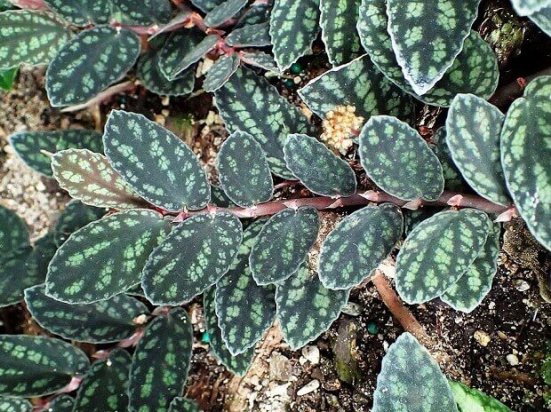
1.10 Watering
Water regularly throughout the year, and allow the soil to dry slightly before each watering. Excess moisture from the pallet should be drained a few minutes after watering.
1.12 Pests and diseases
Leaves can be burned if exposed to direct sunlight. Plants rot if there is insufficient drainage, too frequent watering, or too low a maintenance temperature. Among harmful insects, whiteflies, spider mites, mealybugs, and aphids can pose a certain danger.
Insects are pests
| Insect name | Signs of infection | Control measures |
| Whitefly | Small light spots on leaf blades, yellowing and foliage falling off.Disturbed white, small butterflies take off from the surface of the leaves | Chemicals: Zeta, Rovikurt, INTA-VIR, Fufanol and even Karbofos, Actellik, Aktara, Confidor, Commander, Tanrek. Folk remedies: soap solution, garlic solution, infusion of yarrow and tobacco, infusion of dandelions, adhesive traps for adult insects |
| Mealybug or felt insect | The surface of the leaves and shoots is covered with fluffy, cotton-like white bloom. Plants are lagging behind | Folk remedies: spraying with soap and alcohol solution. Infusion of tobacco, garlic, cyclamen tubers, alcohol treatments, pharmaceutical tincture of calendula proved to be good. Chemicals: green soap solution, Actellik, Fitoverm. |
| Spider mite | Subtle spider webs on the leaves, yellowing and foliage falling off with extensive lesions. The surface of the sheet plates becomes dead and covered with small cracks. Plant development slows down. | Folk ways. Plants can be rinsed in the shower and left in the bathroom in a humid atmosphere for half an hour. Irradiation with an ultraviolet lamp every week for 2 minutes. Chemical preparations based on pyrethrum, sulfur powders, Fitoverm, Actellik. |
| Aphid | Sticky droplets appear on the leaf plates, the leaf plates curl and deform, delicate buds and young leaves wither. Insect colonies can be seen on the tops of the shoots, buds or the underside of the leaf plates. The flowers of aphid-infested plants may become deformed. | Folk methods: infusion of nettle, decoction of rhubarb leaves, wormwood, soap solution, infusion of tobacco and dandelion, onions, marigolds, yarrow, tansy, dusting with wood ash. Chemical preparations: Sulfur powders, green mass treatment with green potash soap without getting into the ground, Decis, Aktellik, Fitoverm. |
-
Whitefly
-
Mealybug
-
Spider mite
-
Aphid
1.13 Note
Pellionia can live without any problems for many years in indoor conditions. Some plants lose lower leaves with age and become unattractive - they are replaced with new ones obtained with the help of cuttings. Pellionia will make the air in the room cleaner.
Hydroponics.
You may also be interested in:
Peperomia
Plectrantus
Ripsalis
Aspidistra
Reproduction
Seed and vegetative propagation methods are available.
Seed planting
Pellionia seeds remain viable for two years. They are sown in the spring in a wet sand-peat mixture or in a ready-made substrate for growing seedlings. The seeding depth is no more than 1.5 cm. The first shoots appear already in the second week after planting. You can cover the pot before they appear with glass or film, or you can not, there is no big difference in the timing and quality of seedlings. Transplanting into a permanent pot is carried out at the stage of the formation of the second pair of true leaves.
Cuttings
Pellionia reproduces very easily vegetatively. The easiest way to do this is to use the grafting method, for which the stem is cut into segments with 2-4 internodes. The presence of a tip on the handle does not matter. Rooting without problems occurs in any substrate and even in a glass of water. After the first roots have appeared, the cuttings are planted in a permanent place with the removal of the lower leaf and deepening the point of its growth into the ground. The minimum length of the buried cut is 1.5-2 cm. Further care is carried out according to the agrotechnology of an adult plant.
Stem layering
Not the most convenient, but just as fast breeding method. To do this, the freely hanging stem is pressed tightly to the ground in a freestanding container, pinned with a wooden slingshot or simply laid on the surface of the earth. If you ensure its complete rest, then in the place of contact with the ground, the stem will very soon take root, and it will only be necessary to carefully separate it from the mother bush.
Pests
More often than others, the culture is annoyed by the ubiquitous aphid and whitefly. The problem is easily eliminated by a preventive or therapeutic shower using laundry soap, infusion of garlic stalks and other folk remedies.
Popular types
Several types are famous.
Pellionia Daveauana
She has strongly branching creeping shoots with a reddish tint, smooth to the touch. Brownish-green leaves with a light stripe, alternately arranged along the central vein, oval in shape. They grow in length up to 6 cm. Along the edges of the leaves are purple-black, and their back has a gray-greenish color with a red tint and a rough surface. On each leaf, at the base, you can see a pair of scarious reddish stipules. Small greenish flowers are formed in summer.
Pellionia beautiful or beautiful (Pellionia pulchra)
Outwardly, it resembles the Davo Pellionia, but has a more miniature size. Elliptical leaves grow only 2-4 cm in length. Above, their color is silvery, along the veins it is dark green. The resulting marble-like ornament is very beautiful. On the underside, a pink-green leaf blade with red-violet veins is covered with short hairs. Flowers are small, pale, not very noticeable.
Pellionia short-leaved (Pellionia brevifolia)
Has a creeping stem, branchy pubescent shoots of a reddish color. On ovoid leaves there is an asymmetrical pattern of a grayish-silvery shade. Subulate stipules and cuttings up to 2 cm long. This species is characterized by small inflorescences with flowers of 2 sexes, but sometimes monoecious.
Creeping Pellionia (Pellionia repens)
This species has creeping fleshy stems, which in the wild can easily cling to rocks or walls and climb to a height of 50 cm. Leaves are oval, 4–5 cm long, dense in structure. In the middle, the color of the leaf is light green, and around the edges it is bronze-green. Under favorable conditions, this Pellionia lives from 4 to 5 years. It blooms only in its usual natural environment.
At home, it is recommended to breed Davo Pellionia and Beautiful Pellionia.
Pellionia care at home
This plant is unpopular among gardeners, despite the fact that it is not very demanding to care for and is often found in specialty stores.
Illumination
The best spot for Pellionia is at the back of a well-lit room. It can grow in the complete absence of sunlight, but in this case, you will need phytolamp illumination. The plant feels fine in partial shade and it is not recommended to get direct sunlight on the foliage.
Temperature regime
He loves warmth, but at the same time the heat negatively affects him. So, in the warm season, he is recommended a temperature of 20 to 24 degrees. With the onset of the winter period, the temperature is slightly lowered, but it should not be less than 16 degrees.
Reacts well to regular airing of the room, but at the same time, Pellionia should be protected from drafts.
How to water
Throughout the year, abundant systematic watering is needed. To do this, use slightly lukewarm and settled water. The soil in the flower pot should be slightly damp all the time, but not wet. Stagnant water in the soil negatively affects the root system.
Humidity
Increased air humidity is needed. To maintain it at the proper level, it is necessary to pour a little expanded clay or pebbles into the pallet and pour in water. And it is also necessary to spray the foliage at least 2 times a day.
Earth mixture
Needs light and nutrient-rich soil. For planting, a commercially available universal flower soil is suitable, into which you should add a small amount of a baking powder, for example, such as: vermiculite, perlite or brick chips.You can also make a soil mixture with your own hands, for this by mixing humus, leaf and peat soil, as well as coarse sand in a ratio of 1: 2: 1: 1.
Flower pots are low and wide because the root system is close to the soil surface. Don't forget good drainage.
Can grow hydroponically.
Fertilizer
Top dressing is carried out infrequently during active growth, once a month. To do this, use a complex fertilizer for ornamental deciduous plants (use ½ part of the dose from the recommended dosage indicated on the package). In winter, fertilizers are not applied to the soil.
Features of pruning and transplanting
While the Pellionia is young, it is recommended to pinch it to form a more lush crown, but the matured flower does not need it. It grows very quickly and it is recommended to renew the plant after 1–2 years. For these reasons, a transplant is not required.
Reproduction methods
Can be grown from seed and propagated by cuttings. For the cutting, the tops of the stems are cut off, while it is worth considering that they must have at least three internodes. It takes root quickly after about a week.
Pests
Most often, whitefly settles, as well as aphids. For the preventive purposes of Pellionia, a systematic warm shower is recommended. This will eliminate the need to use chemicals.
Application
It is often used to compose flower arrangements or mixes consisting of several different flowers. As a rule, terrariums, florariums, and also bottle gardens are used to create them.
They also grow it as an ampelous plant in hanging pots, and also as a ground cover plant, while combining it with single large flowers.
Possible problems
Due to improper care, several problems can arise:
- The tips of the leaves dry out - low humidity.
- Rotting of the root collar and roots - stagnation of water in the soil.
- The color of the leaves has become pale - too much light.
- The shoots are very elongated - there is little light.
Popular types
Several types are famous.
Pellionia Daveauana
She has strongly branching creeping shoots with a reddish tint, smooth to the touch. Brownish-green leaves with a light stripe, alternately arranged along the central vein, oval in shape. They grow in length up to 6 cm. Along the edges of the leaves are purple-black, and their back has a gray-greenish color with a red tint and a rough surface. On each leaf, at the base, you can see a pair of scarious reddish stipules. Small greenish flowers are formed in summer.
Pellionia beautiful or beautiful (Pellionia pulchra)
Outwardly, it resembles the Davo Pellionia, but has a more miniature size. Elliptical leaves grow only 2-4 cm in length. Above, their color is silvery, along the veins it is dark green. The resulting marble-like ornament is very beautiful. On the underside, a pink-green leaf blade with red-violet veins is covered with short hairs. Flowers are small, pale, not very noticeable.
Pellionia short-leaved (Pellionia brevifolia)
Has a creeping stem, branchy pubescent shoots of a reddish color. On ovoid leaves there is an asymmetrical pattern of a grayish-silvery shade. Subulate stipules and cuttings up to 2 cm long. This species is characterized by small inflorescences with flowers of 2 sexes, but sometimes monoecious.
Creeping Pellionia (Pellionia repens)
This species has creeping fleshy stems, which in the wild can easily cling to rocks or walls and climb to a height of 50 cm. Leaves are oval, 4–5 cm long, dense in structure. In the middle, the color of the leaf is light green, and around the edges it is bronze-green. Under favorable conditions, this Pellionia lives from 4 to 5 years. It blooms only in its usual natural environment.
At home, it is recommended to breed Davo Pellionia and Beautiful Pellionia.
Types of stocks with photos and descriptions
The stapelia is star-shaped. Stapelia asterias masson
Low flower culture, reaching a height of no more than twenty centimeters. The shoots are rich green, sometimes with a burgundy tint and small, weakly pronounced teeth.
From the starting point of the shoots, buds appear on a long stem, after a while they bloom and acquire a pronounced star shape. The light corolla is framed with light fluffiness, the petals are slightly corrugated, pale burgundy.
The stapelia is gigantic. Stapelia qiqantea
The plant received this name for the large size of the flowers. In diameter, they are capable of reaching lengths of up to thirty centimeters.
The flower petals are triangular in shape, slightly elongated and pointed at the ends. The edges are slightly curved outward and covered with light fluffy villi. Corolla slightly flat and deeply dissected.
Stapelia variegated or variegated stapelia varieqata
This is a fairly compact plant, its height is no more than ten centimeters. The bright green shoots can sometimes turn reddish. Flower teeth are erect with blunt edges.
The petals are triangular in shape with pointed tips and are slightly curved. The color is variegated and bright, accompanied by brown stripes on the yellowness covering the flower.
This variety has very unusual flowers. They own a wide-open corolla with petals very small in diameter. The main leaves are slightly elongated, triangular and slightly curved back.
But the most important feature is the long transparent - white clavate glands that densely cover the entire surface of the flower.
The stapelia are golden purple. Stapelia flavopurpurea
They are small succulents with purple flowers and a distinct star shape. The height of the flowers does not even reach ten centimeters, the corolla reaches four centimeters in diameter, has a dissected flat shape.
The disc is always light in color with lush hairs. Surprisingly, this variety has a pleasant smell.
The stapelia is changeable. Stapelia mutabilis
A succulent of hybrid origin. Shoots of medium height, reaching fifteen centimeters. The flowers are arranged on long pedicels, the corolla is large and flat.
The petals are triangular-ovate with transverse stripes and dots, can have a variety of shades and colors.
Hairy
The flowers of this variety are small, but very distinguished by their beauty. The leaves on the flowers stretch in different directions and are strongly bent back.
The surface is covered with a long, delicate edging. The colors of this type of succulent can be varied. From brownish yellow to brownish pink.
Standing-flowered
This kind of culture fully lives up to its name. Buds appear on long young shoots. Shoots grow from the center, middle part, or top of the main stem.
Small flowers with a purple corolla. The petals are strongly curved and cover the stem. The petals are rounded and corrugated. The entire surface of the flower is covered with thick lush hairs.
Stapelia gigantea. Stapelia qiqantea
This type of succulent has rather large five-membered flowers. The inner surface of the petals is wrinkled, covered with brownish markings and small hairs.
The tips of the petals are elongated and surrounded by a light dense edging at the edges. The dark purple color of the crown blends into the leaves and stands out with brownish markings.
Guernia
This is a close relative of the stocks. This decorative species has small bushes with short tetrahedral stems of gray-green color.
Flowers are usually small, up to three centimeters in diameter. Two or three flowers may open immediately, which initially represent a small roller with five outer petals.
Diseases and pests
May be affected by aphids and whiteflies.
For prophylaxis, an ornamental bush is sprayed under a stream of warm water. You must first cover the roots with a plastic bag. Whiteflies look like powdery pollen. At the first symptoms of damage, chemical methods of control are used. Well suited drugs "Pegas", "Aktara", "Confidor", "Fitoverm", "Arrivo".
If aphids are affected, the infected areas are removed. The plant is treated with oil products. Poisonous drugs can be used. After processing, the plant should be covered with a small film.
If the plant has ceased to bloom or grow, then the growing conditions are violated.
Due to the fact that the plant is shade-loving, too bright light may be the main reason. It is also necessary to reduce or increase watering, remove the flower from heating devices, or transplant more fortified acidic soil.
Types of Pellionia with a photo
The genus is estimated at fifty varieties that grow in the East Asian region (China, Malaysia, Burma), as well as in Polynesia. Only a few of them are suitable for home breeding, and if you approach the issue of care strictly, then there are only two unpretentious species (Davo and Beautiful), easily grown in room conditions. Most often, it is them that can be found on sale.
Pellionia Davo
Creeping herbaceous perennial with strong branching at the base. Shoots are thickened, smooth, reddish. Oval asymmetric leaves of the next arrangement sit on short petioles, the length of the leaf plate is about 6 cm, the edge is slightly gorbate. The color is predominantly bright green, with a light irregular stripe along the central vein. On the outside, the surface of the sheet is smooth, glossy, on the back - rough, has reddish streaks.
Flowering occurs in the summer, like all representatives of the genus, it is barely noticeable and inconspicuous. In nature, the perennial has a wide distribution range from humid tropical forests to rather dry rocky areas, so at home this plant often forgives caregivers and is considered the most unpretentious variety. It easily takes root in the places of contact of internodes with the soil.
Pellionia beautiful (beautiful)
It differs from the previous species in smaller leaves, in length they grow by 4 cm. The color is variegated, silvery-green, in some varietal varieties with a darker brown-burgundy slightly-crested edge. The surface of the leaf is leathery, glossy. The seamy side is covered with light pubescence, has a lighter silvery-pinkish color. Inflorescences are umbellate, small, loose. At home, they are usually trimmed.
Pellionia short-leaved
Variety with strongly branched creeping shoots of a reddish color. The leaves are long-petiolate, elliptical, with an asymmetrical silvery pattern that repeats the pattern of the veins.
Pellionia creeping
Differs in the ability to climb surfaces, clinging to walls or rocky ledges with its fleshy shoots. However, the shoots usually do not grow more than half a meter in length. Leaf plates are asymmetrically oval in shape, up to 5 cm long, with a dense relief structure, feel like paper to the touch. In the middle, the color of the leaf is light, light green, along the edge of a very dark green.
Pellionia
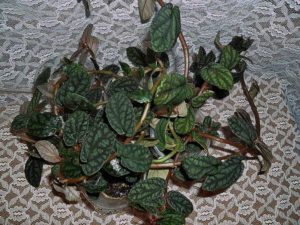
A genus such as Pellionia is directly related to the nettle family (Urticaceae). In this genus, there are about 50 species of herbaceous plants that are perennials.
They can have both erect and creeping stems, which are strongly branching at the base. In nature, they can be found in the tropical zones of Polynesia, as well as East Asia. Only a couple of species of this plant can be grown at home.
And all because the conditions for their cultivation there are extremely unfavorable.
Pellionia daveauana
It has bare, rather thick shoots, painted in a pale brown color, and on them are alternately asymmetric broad-lanceolate leaves with heart-shaped bases, as well as short cuttings. The surface of the leaves is smooth, slightly gorbate, and they reach 4–6 centimeters in length. They have an unusual and beautiful color.
A rather wide, longitudinal stripe of a pale, greenish-grayish color runs right in the center. And along the edge of the leaves are painted in a dark, almost black, shimmering purple color. The seamy side of the leaf is green-gray.
On creeping stems, roots are formed in places where the nodes touch the soil surface, due to this, a fairly rapid growth in all directions occurs.
Beautiful Pellionia (Pellionia pulchra)
It has a smaller size compared to Pellionia Davo, and also a completely different color. The maximum length of the leaves is 4 centimeters. On the gray-silver face of the leaf, there are dark green stripes along the veins. The seamy side is grayish pink.
Both species have small white-green flowers, collected in loose inflorescences in the form of umbrellas and are not of any decorative value. Home-grown plants tend to be pruned.
Pellionia care at home
This plant is unpopular among gardeners, despite the fact that it is not very demanding to care for and is often found in specialty stores.
How to water
Throughout the year, abundant systematic watering is needed. To do this, use slightly lukewarm and settled water. The soil in the flower pot should be slightly damp all the time, but not wet. Stagnant water in the soil negatively affects the root system.


